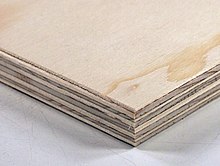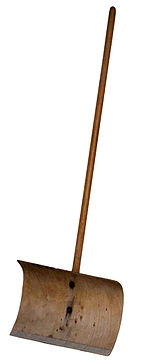plywood
Plywood is a widespread wood-based material with high strength and dimensional stability with applications u. a. in construction and the furniture industry. It consists of at least three layers of wood, the grain of which is glued and pressed at an angle of 90 °. As a result, directional material properties such as For example, the swelling and shrinkage behavior is homogenized over the plane of the board, the resulting material no longer “works” significantly, in contrast to solid wood, the wood is “blocked off”. The panel structure and its specific strength properties result from the type, number and arrangement of the wood layers.
Plywood types
The layers of plywood can consist of solid wood panels, veneers, rods or other wooden materials. Depending on this, a distinction is made between
- Rod or rods plywood , also blockboard called, consists of a middle layer of sawn timber strips (bars), or peeling veneer strips (rods).
- Veneer plywood , also called veneer board , consists exclusively of an odd number of veneers , which are glued crosswise symmetrically to the veneer middle layer. A board over 12 mm thick and with at least five layers is called a multiplex board .
- Cross- laminated timber , also known as cross-laminated timber , consists of several solid wood panels lying crosswise and flat on top of each other. Cross-laminated timber structures are among the solid wood construction methods.
- Composite plywood consists of one or more inner layers of other wood-based materials such as chipboard or non-wood-containing materials such as plastic layers, for example for sound insulation. The outer layers are made of veneer.
- Special shapes such as diagonal and star wood are of less importance in practice . In the case of diagonal wood, the grain of the veneer changes between 45 and 135 degrees in relation to a reference edge. The veneers are thus aligned diagonally with the grain, but they are laid crosswise to one another. One speaks of star wood when the veneer layers shift from sheet to sheet at an angle of between 15 and 45 degrees.
With laminated veneer lumber , on the other hand, the veneer layers are glued parallel to each other, so that the strength properties depend more on the direction of the load than with plywood.
history
4000 years ago, panels for furniture construction were already being made in a locked manner in Egypt. There were several reasons for this: On the one hand, large trees and usable trunks were rare in the desert country of Egypt, while veneer made it possible for the furniture to look even and elegant. On the other hand, the blocked construction compensates for the movement behavior of the material wood by swelling and shrinking. The basic idea was to glue several layers of wood veneer alternately so that the grain directions of successive layers run at right angles to each other. In this way, the wood veneers block each other in their movement behavior. Hence the name "plywood".
After the process was forgotten, it was rediscovered in the middle of the 19th century: wood technicians took up the idea of barriers around 1860 and they developed the new material plywood. Bruno Harras founded the world's first plywood factory in 1858 in Böhlen (Thuringia) . Due to the rapid takeover in industrial production, plywood became an important material for woodworking, in furniture production and in vehicle and aircraft construction.
Manufacturing

For almost all types of plywood, dried wood layers are glued, placed crosswise (biaxially) on top of each other and pressed under the influence of heat. Special presses enable any shape to be produced - peeled beech veneers are predominantly used here.
Numerous types of wood can be used as raw materials. In addition to the availability of the wood, it is crucial that it is easy to peel. The native hardwood species beech, birch and poplar, as well as maple, oak, ash and linden, are suitable for plywood production. Spruce and pine are mainly used as coniferous woods. Well-known and suitable non-European types of wood are Okoumé, Limba, Abachi and Fuma / Ceiba. Most plywood is made from veneers of one type of wood, but there are also combination products.
The plywood types differ in their structure:
For veneer plywood , veneers with a thickness between 0.8 and 4 mm are technically dried, glued and placed in appropriate veneer blanks. Depending on the number and thickness of the veneers, the veneer plywood is between a few millimeters and several centimeters thick. The finishing of the veneer plywood takes place in presses at high pressure and press temperatures of around 150 ° C. After it has cooled down, it is trimmed, sanded and cut to the desired final dimensions.
The production of molded plywood is basically similar, but the glued veneers are brought into a permanent three-dimensional shape in so-called dies. The laying itself determines the later property profile. If dimensionally stable, rigid molded parts are required, for example seat shells, the veneers are laid and pressed crosswise, as is usual with veneer plywood. For the so-called cantilever chairs, on the other hand, a high tensile strength is important, which is why the veneer layers are arranged with parallel fibers (laminated veneer lumber). Particularly intelligent chair designs combine both laying principles.
In the production of plywood , a middle layer of usually 24 to 30 mm wide wooden bars ("sticks") is laid and bonded or stapled with glue. The middle layer of stick or stick plywood is glued crosswise on both sides with a veneer. In the case of stick plywood, the middle layer consists of peeled veneer strips up to 8 mm thick, upright to the board level. This results in standing annual rings in the central position, which leads to particularly good stamina and high surface smoothness.
use
From a purely visual point of view, plywood is most similar to solid wood among wood-based materials. Its industrial history of around 150 years has made it a mature material that designers and constructors often use. Plywood is used in particular where thin cross-sections are required despite high loads. In terms of strength and dimensional stability, plywood has a clear advantage over chipboard .
There is a wide range of uses for plywood:
Vehicle construction, transport and traffic: Plywood panels are used for floor and wall systems in vehicle construction and trailer construction. The plates are mainly used in the areas of cargo space protection floors for box vehicles, trailer floor plates, but also as well as highly stressed floor plates for flatbeds and heavy commercial vehicles.
Ship and boat building: Although ships and boats are mostly made of metal or fiber-reinforced plastics today, wood on board still plays an important role. Technical parts: Plywood impresses as a technical all-rounder: it impresses with its high flexural and tensile strength as well as its impact and notched impact strength.
Construction and building equipment: Construction is one of the most important uses for plywood. Depending on the type of gluing, it is used inside or outside, for example, for formwork construction, interior work, in structural and flat applications.
Furniture construction: As in structural timber construction, the favorable ratio of weight to strength is also convincing in furniture construction. Plywood for furniture construction is usually not glued waterproof and is particularly suitable for flat parts of box furniture.
Bed and spring slats: Modern bed substructures made of plywood help you lie well. The flexible material cushions movements and supports the back.
Door and window blanks: Veneer plywood or blockboard are used primarily for door panels (e.g. in rooms with high humidity) and in frame and frame production. Thin veneer plywood is popular as decorative cover panels.
Skis and boards: Many skiers and snowboarders do not even know that almost every racing ski and numerous snowboards have a wooden core made of peeled veneer. Plywood is the ideal material when it comes to combining lightness and dimensional stability.
Model and tool making: Plywood is widely used in the aircraft and automotive industries for cost- and time-saving first model production of future series products. Plywood is also a popular material for architectural models. In presentations, competitions or exhibitions, plywood models are handsome, durable and stable.
Sound and Music: Sound furniture manufacturers often use plywood. Heavy beech wood veneer panels and molded plywood are particularly suitable for high-quality speaker systems.
Economical meaning
Measured against the total production of wood-based materials , plywood only accounts for a small part at around 1.5%. In 2008, 175,000 m³ of plywood were produced in Germany, including a little over 150,000 m³ of blockboard (stick or stick plywood) and 22,000 m³ of veneer plywood. In Europe, plywood production was around 7.8 million m³ in 2018. This is used in the construction sector (39%) and for furniture production (30%). For the other uses, transport and packaging play the main role.
literature
- André Wagenführ, Frieder Scholz: Pocket book of wood technology. Fachbuchverlag at Carl Hanser Verlag, Leipzig 2008, ISBN 978-3-446-22852-8 , pp. 127-259.
Web links
- Association of the German Wood Materials Industry V
- www.sperrholz-info.de
- European Panel Federation (English)
- Gesamtverband deutscher Holzhandel e. V.
- Manufacturing plywood boards: then and now on YouTube , Victoria and Albert Museum
Individual evidence
- ^ Information service wood special plywood , February 2008, p. 4. Information service wood of the Informationsverein Holz e. V., Berlin, accessed on October 16, 2015
- ↑ www.sperrholz-info.de [1] , accessed on June 5, 2020
- ^ Association of the German Wood Materials Industry (VHI) with reference to the European Panel Federation (EPF). Industry data 2018.

